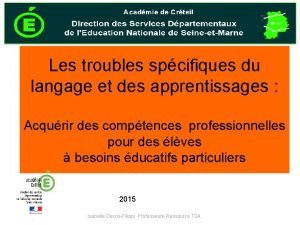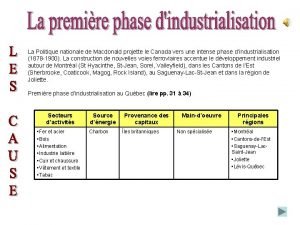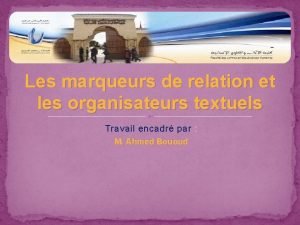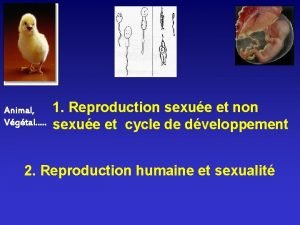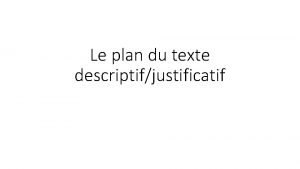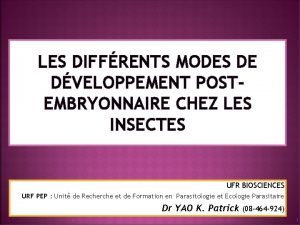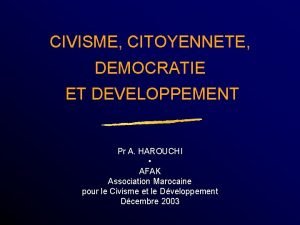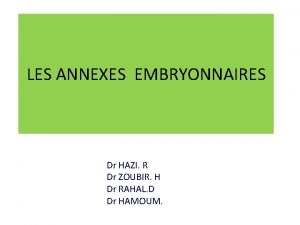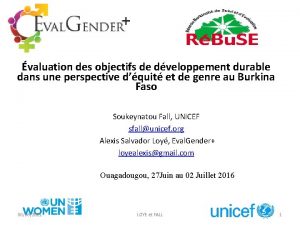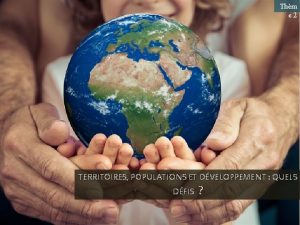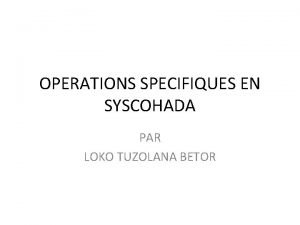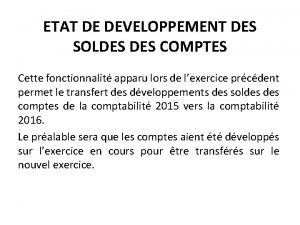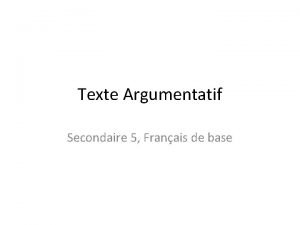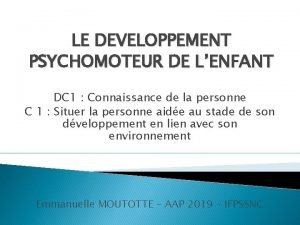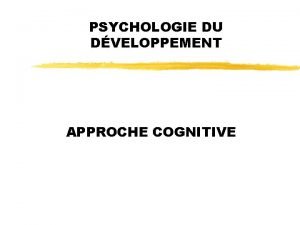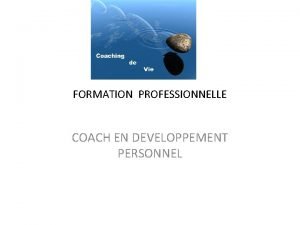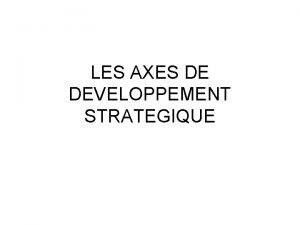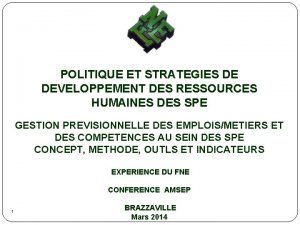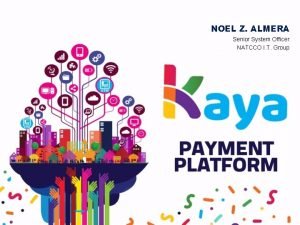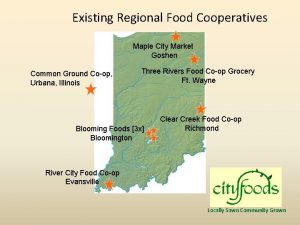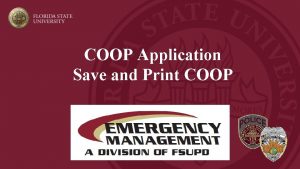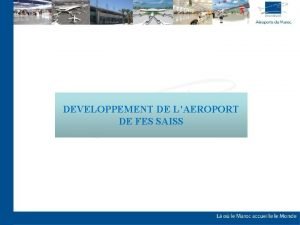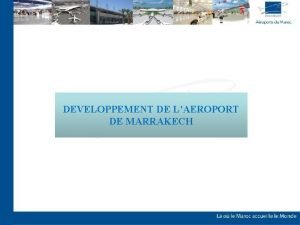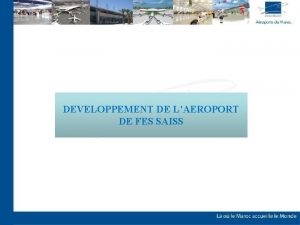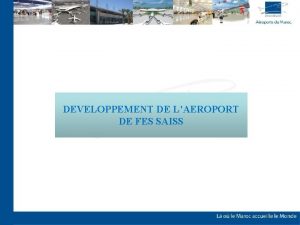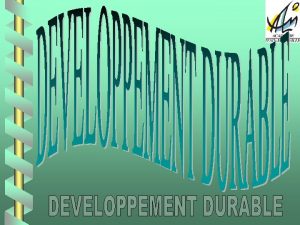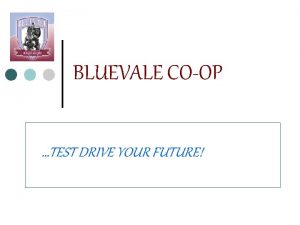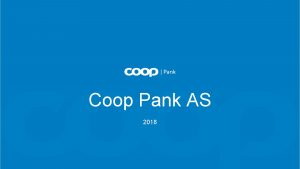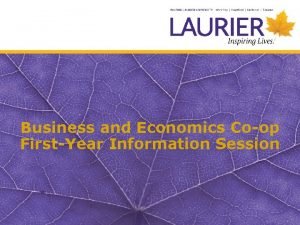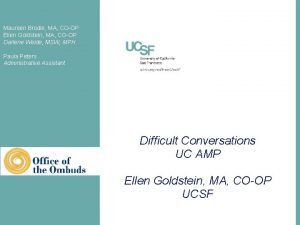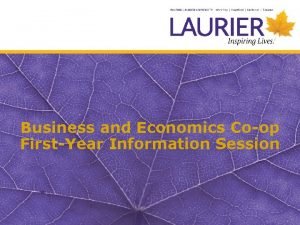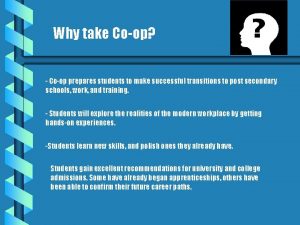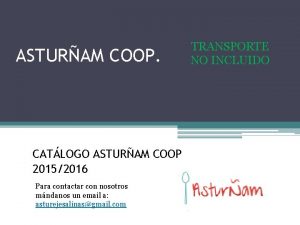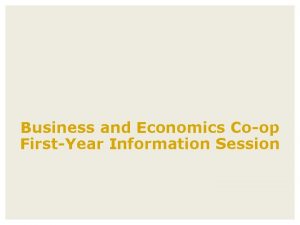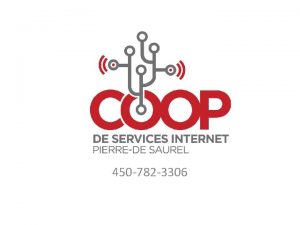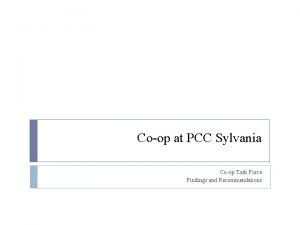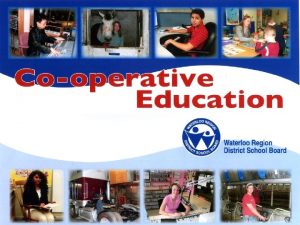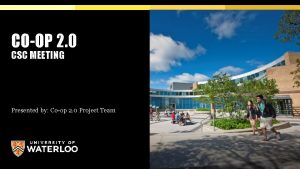COOP DEVELOPPEMENT MUSEOGRAPHIQUE COOP PORTFOLIO IN PROGRESS 5

























- Slides: 25

COOP DEVELOPPEMENT MUSEOGRAPHIQUE COOP PORTFOLIO IN PROGRESS (5)

COOP Avant-projet Sommaire de Muséographie Le document reprend la logique de distribution des contenus sur l’ensemble des espaces intérieurs du COOP selon une logique de 15 stations.

STATION 1 ( hall d’entrée) Where am I ? What happened and happens here? What to expect ? HISTOIRE/MESSAGE Here, in this area, Cureghem, we do not only live. We work and produce, now and in the past. And for the future. This building were you are now dates from the 19 th century and served until 19… as one of the biggest mills (enterprises Moulart), supplying Brussels with the necessary flour for its bakeries and inhabitants. It is just one of a multitude of fascinating activities and links that these areas around the canal Brussels-Charleroi had and have with Brussels and the world. We want to share these with you. You are met and welcomed by some of the (young) people from the area, telling us about their lives, troubles and dreams. You’ll meet them again all over the building. What is this second hand car doing here? It links the area to the world, as a bit further nowadays a new and bustling commercial activity has seen the light over the years, the trade of buying and selling second hand vehicles and transporting them to Africa and the Middle East mainly. It has quite an impact on the neighbourhood and serves to understand it from a different, very contemporary angle. Here we see all kinds of objects and products that have been made in this building and this area over the years (…. ), some of them donated by the inhabitants. This building and its history engages us to try and understand what we do here. We explore it through a maquette that shows us not only what happened here, but also why it was established right here along the canal. We get a general introduction and feeling of where what can be seen here, explained, understood, experienced, and what we can even make ourselves here. LOGISTIQUE -Maquette Moulart et canal -Voiture d’occasion - Témoignages de cette réalité ( objets personnels? Interviews? Audio? . . . ) - Mise en présence des outils et vêtements d’activité – Utilisation de ceux-ci ? - Vestiaire - Vitrines avec objets Moulart ( hall d’entrée ou silo béton pendre chapeaux, pneus, graines, pigeons en plastique, machines outils) ACTION DU GROUPE - Visite compréhension des enjeux de la visite Rencontre avec l’animateur/trice MEDIATIONS/FLASH CONTENUS - Histoire Moulart et des activités. Guido - La meunerie et la logique d’implantation en bord de ville et de canal ( énergie, importation, exportation) comme introduction au soussilo. guido ACTUALISATION - Autour de la voiture : Mise en miroir des réalités présentes avec des liens au local et aux relations internationales version aujourd’hui. guido

STATION 2 ( sous-silo côté droit) Fournir la ville, fournir le monde HISTOIRE/MESSAGE Here we are in the former sub-silo area of the mill, and we’ll submerge you into its industrial past. How were the products made here and how? In this building, on the Quai Demets and surrounding area, many of these products were and are made. They need raw materials, energy, manpower, organization, transport. How do the raw materials get here, how are they treated and transformed, through what production means? A panoply op raw and finished products and production means submerge us in the production world of breweries, wheat production, slaughterhouses, machine tools, production lines. We hear machines, see primitive and sophisticated production chains. We smell oil and dust, see people working and labouring. And try to understand the changing circumstances over time and how life and work in the factories and enterprises was organised. We wander around and learn and see how transport was organised and how the products got to the customers. ((How we consume them? )) LOGISTIQUE - Mur de droite : Mobilier adapté pour recevoir des objets, des textes flashs, des images fixes - Mur de gauche en pente : projections de production diverses ( brasseries, meunerie, abattoir, machines outils en choisissant des images en mouvement de type chaine de production, chaine d’abattage, grain tombant/défilant) On essaiera d’utiliser le premier espace pour des images de production et le second pour des images de transport/export/port - Des images de consommation de différentes époques pourraient être incluses en 3 ACTION DU GROUPE L’interaction avec le groupe se fait par les images et les objets du mur de droite. Une ambiance sonore appuyée est recherchée. On songe à une déambulation libre des visiteurs. MEDIATIONS/FLASH CONTENUS Elles interviennent dans les armoires de droite et en surimpression des films ( slogans) - Différentes productions, usines et métiers du quai ( beroefen). Note Guido ACTUALISATION

STATION 3 ( sous-silo côté gauche) Le pain de l’industrie HISTOIRE/MESSAGE We are still in the sub-silo area. Producing all these supplies for the city needs energy. Coal used to be the main source of energy. But where did coal come from and how was it excavated ? Is it still used? How was it transported ? Why through the canal and not by the railway or trucks or by existing waterways? On the Quai Demets several coal distributors were operational. You’ll experience how coal production took place in the South of Belgium and the hard labour of the miners, often migrant workers. We get an idea of how energy was used in enterprises such as Moulart, how it served for steam engines and producing electricity. A nearby electricity station serves as example. Getting the coal and other raw materials to Brussels was a major enterprise. A canal was built between Charleroi and Brussels, a major work of civil engineering, with several locks and bridges. Why were these locks built and how do they function? What use have we of them today? The nearby lock of Molenbeek serves as example. The canal was and still is part of a sophisticated network of inland waterways – a very contemporary transport system, by the way, futureoriented. And let us not forget that boats were also hauled by humans in the old days! Nowadays of course we get energy from all kinds of different sources. We dwell on that upstairs. LOGISTIQUE - Dispositif avec charbon ? - Images sur le mur en pente liées à l’extraction, le transport ( par le canal ) et l’utilisation des sources d’énergie ( dans les entreprises, machines à vapeur, centrale électrique) - Sur le mur de droite des flashs textes, images mettant en lien l’approvisionnement avec le canal de Charleroi et les différents ouvrages civils construits ( élargissement du canal, ponts et écluses) ACTION DU GROUPE L’interaction avec le groupe se fait par les images et les objets du mur de droite. Une ambiance sonore appuyée est recherchée. On songe à une déambulation libre des visiteurs. MEDIATIONS/FLASH CONTENUS -Centrale électrique de la stib. Note Guido (existe) -Fournisseurs de charbon du quai ( Moulart, comptoir des cokes). Note Guido -écluse de Molenbeek. Note pierre - le halage et l’énergie humaine. Note Guido+pierre ACTUALISATION


STATION 4 (studio) RICH MAN POOR MAN HISTOIRE/MESSAGE Here you are in the Western part of Brussels, traditionally known as ‘workers areas’, where the workers lived near to the factories and enterprises. That is how these quarters grew and why so many technical schools were established here, not only for the various large industries that were established here, but also to form and educate the workforce for the many ateliers that saw the light here. That is how Anderlecht grew and attracted its inhabitants. The relation between the industrialists and the workers structured social life in the area. We look into the right to vote, that brought about many ®evolutions. Here? The urbanization of Brussels brought with it a clear divide: the East of the city was were the more well-to-do lived, the ‘bourgeois’. This is still predominantly the case. Brussels was at that time structured by the great urbanistic dream of King Leopold II who used the proceeds of the Congo to do so. Well-to-do areas such as the Quartier Leopold in the East were built, the ring road also. The natural environment of Brussel and its hydrography also played a role in the urbanisation of the city. We look into the year 1870 when there was a tentative gentrification (? ) These developments shaped Brussels into the very dual city it is today. Since the 1970’s and the first economic crisis after the promising 60’s, these areas were gradually abandoned and disinvested by the authorities and traditional business circles, leading to today’s complex situation with its many challenges of urban regeneration and experimentation. These areas in Cureghem were and are among the cheapest to live in Brussels. They were also bordering the Midi Railway station, welcoming migrant workers. But as soon many inhabitants had the means, they would go and live in ‘better’ areas. And this also is still the case today. But suppose that at the time, it would have been decided to build the Hippodrome of Brussels over here, as historical research points out…? We might have seen a completely different urban evolution pattern…. ? LOGISTIQUE “The horse” scale 1: 1 (stuffed horse from the Veterinary School in Anderlecht ) Hippodrome ( what drawings, plans do exist? ) ACTION DU GROUPE ? MEDIATIONS/LIENS VERS DES CONTENUS - Quelques réalisations symptomatiques : commune d’Anderlecht, écoles techniques, Léopold 2, les grands travaux urbains à l’est ( quartier Léopold, grande ceinture, …)Guido - Les grands travaux industriels à l’ouest. Guido - Rappel de la notion d’hydrographie qui a appelé l’urbanisation. Guido - Figures de l’ouvrier et de l’industriel, leur relation, la maison/porte cochère- atelier. Guido - 1870 : tentative de gentrification. Guido MEDIAS VISUELS Images for projection (2, 4 x 2, 0 m): Pictures from daily life from 1870 - The divided city The horse in the society, production, transportation The hores pulling barges The animal market (Hippodrome area) The production of horseshoes, saddles, etc. ACTUALISATION ?

STATION 5 ( Studio) MANKIND 1, Industrialisation starts, with immigrants from…. . Flanders HISTOIRE/MESSAGE Who knows that from 1870 onwards, the first ‘migrant workers’ who came to work in the Brussels’ bourgeoning industries came from Flanders, in search of employment? Flanders had suffered a major famine in these days and was in general a poor area compared to the rest of the country. The Flemish workers were mainly employed in the clothing industry and the many textile ateliers. We analyse the situation in these various ateliers, that were the forebears of the industrialization. But at the same time we look at this industry that has long disappeared from Brussels. We now buy clothes that are made in sweatshops in the Far East. Were the working circumstances in those days in Cureghem worse than now over there, 150 year on? Let’s check. Flanders was very catholic at the time and the Church feared the influence of socialism on the poor Flemish workers. The railways and other public transport facilities even received subsidies from the Church so that the workers could continue to live in their villages in Flanders, far from the bad influences of the ‘city’ and socialism…. The ‘Boerentram’ dropped the fathers in the factories and the kids in the schools, the wives and mothers stayed in the villages… With this first influx of workers came also very many associations where they met in search of companionship and leisure. Cultural life became very diverse. Cycling events were organized (the Flandriens were very well known at the time) etc. LOGISTIQUE -Iconic object: Bikes from 1870 – 2014 The first bikes in the area The knife- grinder bike or other of the same kind The delivery bike 1940… The daily bike 1950 …. The first racing bike…. . The bike of Eddy Merckx The electric commuting bike of today ACTION DU GROUPE La station est structurée autour d’un amas de vêtements des toutes époques et traditions à recher en friperie/ à créer avec un atelier. On veillera à des habits présentant au moins trois pièces pour complexifier le jeu. Chaque habit est lié à une fiche descriptive (brève description de l’époque et le milieu de celui qui le porte). Accent sur rapport habits/classes sociales. Attention à folklorisation Le groupe doit s’habiller et s’inscrire dans un concours de photos 2 catégories : la photo la plus juste ou la photo la plus belle. MEDIATIONS/LIENS VERS DES CONTENUS -La migration interne en particulier flamande à Bruxelles. Note Khalili - Les associations. Khalili - Tracer un topo de ce qu’est déjà la vie industrielle en 1870 sur Cureghem et Molenbeek et secteurs structurants et le type de travail. Guido MEDIAS VISUELS - Course d’eddy merckx - Photo de Merckx avec les maillot cureghem sportif - Interview de Monsieur Van Genck -film sur la confection actuelle dans pays en voie de dvpt Images for projection (2, 4 x 2, 0 m): The everyday life 1870 - 1960 Workers coming to the factory The life in the streets People at the market Street fashion 1870 - 1960 Leisure time and sport activities


STATION 6 (Studio) DES MOTS ET DES IDEES HISTOIRE/MESSAGE This area was a key witness to the revolution in communication and was particularly known for its printing industry with many printing ateliers, providing employment amongst others. In the midst of social and industrial conflict, the printing industry was – and still is - a powerful tool to spread (new) ideas, to fight for social causes such as the price of bread or the need for social housing, the education of the masses etc. . . At the same time, let’s not forget analphabetism was rampant. Of course not only the printing industry served to communicate ideas, so did music, art, photography, film. And, just as today, information was also manipulated. Starting from old printing techniques we look into the development of this industry in its various forms (books, newpapers, magazines, posters etc) until today where we have our own printing machines at home… We make our own communication tools, be it a poster or a pamphlet or a T-shirt to spread our news, views and ideas. We’ll even turn them into an exhibition. Did you know that in this area, during the German occupation in WWII, a printing press served to make a fake ‘Le Soir’, written by the resistance movement. It made headline news all over the world… Right to vote here also? LOGISTIQUE machine d’imprimerie / Ordinateur actuel ACTION DU GROUPE Imprimer sur base de clichés avec des thématiques à choisir. Transformer le dessin en vue d’une exposition créative annuelle. MEDIATIONS/LIENS VERS DES CONTENUS - Le faux soir. La résistance. Guido - L’importance des imprimeries, Guido - L’importance de quelques autres secteurs. Guido - Machine de typographie. guido - l’importance de l’analphabétisme lors du dvpt de l’imprimerie. Khalili - Expression par l’image, musique, fanfares, art. A creuser Guido ? - Les journaux , la presse, impression technique. Guido Actualisation -incursion vers l’époque numérique nouvelle -évolution du secteur de l’information. La manipulation de l’info d’hier et d’auj -référence à Constantin Meunier MEDIAS VISUELS - Photo du curé avec enfants qui vont vers cimetière le long du canal. Guido Images, projections (2, 4 x 2, 0 m): Faux Soir Resistance during the war Newspaper in the daily life, people Sale and distribution of newspapers Workers at the printing industry Wartime in Brussels Conflicts and campaigns


STATION 7 ( Studio) MANKIND 2/New citizens from Eastern Europe (period? ) spark new industries…and friction HISTOIRE/MESSAGE After the First World War people from Hungary, Poland Rumania start to arrive in Brussels, mainly workers. Many of them settle here, in search of a new life in the West - many of them of Jewish descent. We look into these and why and how they settle here. They give a new impetus to the life in the area. At the same time the first signs of xenophobia pop up. During the Second World War there were raffles in Cureghem that met with strong resistance from the local population. Still, many people were caught by the Nazi regime. A monument was erected to remember them. These new immigrants also bring their expertise to the area. In particular their skills in leather work, namely the Jewish immigrants. A whole new sector emerged with tanneries and leather workshops in the textile industry in Anderlecht, linked and made possible through the nearby slaughterhouse. (activité de textile triangle? ? ) LOGISTIQUE- Iconic object: Leather installation , tanning leather , Leather suitcases ACTION DU GROUPE Travail avec du cuir MEDIATIONS/LIENS VERS DES CONTENUS - Documents sur la migration de l’Est à Bruxelles. Khalili - Cette communauté joue une rôle décisif dans l’essor d’un secteur de tannerie et de confection dans le quartier d’Anderlecht - Travail d’entreprises du cuir en lien avec travail abattoir. Guido/khalili - La communauté juive en provenance des mêmes pays de l’est, sera aussi victime en Belgique pendant la guerre des rafles ( rafle de Cureghem), monument Martyr Juifs. khalili -Activités de textile triangle. Guido/khalili Media visual /Images, projections (2, 4 x 2, 0 m): New specialized craftsmen in the area Leather workshops Tanning workers Traders animals, skin Textile in industry workers Sweatshops ? What type of textiles

STATION 8 (Studio) Bread, House and Rights HISTOIRE/MESSAGE (The right to) bread and housing and the story of civil and social rights Bread is life, it is said. We tend to forget that in our opulent society of today. Let’s just look at major revolutions in the world, many of them are and were triggered by issues around the availability of flour and bread - very primary means of living - and their price of course. We can easily state that ‘man follows bread’, and that bread is at the origin of cities, as is water. In this building, where flour was produced for the Brussels market, we will not only bake our own bread, but look into how it is made to the taste of the various inhabitants from all over the world that live here. We will look into the role and price of bread as a very important social question, one of the most basic ones all over the world. We will see how bread making cooperatives will see the light and how people organise themselves around these concrete questions to demand new rights in a changing, industrial (and now post-industrial) society: voting rights, women rights, issues around child labour and social security. Housing cooperatives were established, to improve living conditions of the workers. We do not only look into the social aspects, but also the speculation and gentrification issues around housing, then and now. And how people live in them, then and now. And into new ways of living and new cooperative movements. Notes: Law against child labor Bread and housing Social and civil rights Woting rights LOGISTIQUE Une unité de production manuelle de farine, une unité avec une roue et un moulin ( voir bread factory ) ACTION DU GROUPE Moudre du grain récupérer la farine, faire du pain … MEDIATIONS/LIENS VERS DES CONTENUS -Le prix du pain est une question sociale très importante. khalili/guido - Les organisations ouvrières créent des coopératives de boulangerie ou des coopératives de logement. Guido - Ces regroupements autour de questions concrètes vont avoir un rôle important dans la conquête de nouveaux droits dans la société industrielle : droit de vote, droit des femmes, fin travail enfants, sécurité sociale. Khalili/guido - conditions et modes de logement : social, spéculatif, impasses. Guido -Coopérative de logement de MORTEBEEK. Guido


STATION 9 (Studio) MANKIND 3 -The 60’s: new citizens from the South of Europe HISTOIRE/MESSAGE The sixties especially saw the important arrival of many migrant workers (and gradually their families) for Italy, Turkey, Greece, Spain and Morocco. Many of these families still live in the area. They were called in to supply labour force for the growing economy in Brussels and. Belgium, the mining industry and construction industry being the most important. Life in general and social and industrial relations and the local contexts in the 60’s in particular start to change. Factories were screaming for manpower to sustain fast economic growth. Chain work was and is the name of the game in many of them and will seriously influence working conditions and the well-being of workers in these ‘modern times’. We meet them and familiarize ourselves with their origins, habits, ways of life and how they integrated themselves in their new society. We see how over the years these positive influences also turned into problems: rampant xenophobia, call for their return etc. Many of them will come and live in the West of Brussels and work for the huge infrastructural works of the Brussel’s metro, notably in the 70’s in the nearby commune of Molenbeek. LOGISTIQUE -Une activité impliquant le domaine des abattoirs comme espace de manipulations/ constructions (Les Soldats en terre cuite de Qin Shi Huang ). -Expo in progres constituée d’objets/photos rapportés par le public Iconic object: Big maquette of the Abbatoir covered market. We need plans and drawings of the market and the area to create the maquette ACTION DU GROUPE - Faire les moules, le moulage, la peinture des statuettes. - Apporter des supports personnels, les cher, contribuer à l’expo, réalisation de textes ? ? MEDIATIONS/LIENS VERS DES CONTENUS - les grandes usines à plein pot, sorties d’usine. Guido - le travail à la chaine. Khalili -contexte économique et industriel. Note Guido - la construction du métro dans les années 70 à Molenbeek. Khalili - les origines des migrants, les habitudes, les pratiques, faits sociaux saillants (cfr politique du retour) notes Khalili(plusieurs) - Xénophobie Khalili MEDIAS VISUELS - métro, - expo photo évolutive de cette immigration-là : italiens, grecs, marocains, espagnols de ces années là - Mettre en évidence les secteurs manufacturiers importants : constructions métalliques, construction du métro - Les contextes locaux : 1960 Images, projection (2, 4 x 2, 0): Food culture, people 1950 - 1970 Activities at the market, butchers, greengrocers, fishmongers Shop fronts with people Familys at there dinner table Religious celebrations, holidays, food

STATION 10 (Studio) A school for tomorrow Apprendre pour demain HISTOIRE/MESSAGE – station pas prête) Schools play an important integrating role, also and especially in these areas. How to put all these developments in the area in the right perspective for the future and how to give them sense for the young ones especially? COOP works with the schools and teachers of the area. The young ones in these schools are the future of the area. Due to demographic growth, these schools are attracting more and more pupils. And where else than in these schools can the future be best debated and can change come about? Schools today unfortunately often are agents of inequality, but at the same time they are the best place to talk about integration and citizenship, and to bring them into practice. In this area of the building we give a platform to pupils and teachers to debate about the challenges of education. Note: Is not the hole of COOP an example of the school for tomorrow LOGISTIQUE ACTION DU GROUPE MEDIATIONS/LIENS VERS DES CONTENUS - décrets des écoles -inégalité de l’école en Belgique -l’école matérielle comme lieu d’apprentissage, mais aussi la démarche d’instruction porteuse d’intégration et de citoyenneté MEDIAS VISUELS

STATION 11 ( Studio) MANKIND 4 HISTOIRE/MESSAGE An area of superdiversity and fast changes in population This area has seen successive migration from various nationalities and countries, and since the 90’s also from the new countries of the EU, notably from Poland. But also from countries in Eastern Europe and Africa. Since the fall of the Berlin Wall, the Brussels Government has delivered 100. 000 permits per year, many of them for unskilled and underpaid jobs in the cleaning industy etc. There also has many ‘sans papiers’ on its territory. Most of them live here because the rents are low, not because of the fact that they find work in the area. Many of them do not stay long, on average 1 to 3 years. We are constructing a new and fast changing community here and a new special culture, a new sense of belonging, in constant transformation. And we are proud of it. Many initiatives see the light. COOP is just one of them and hopes to play a central role in this new proudness. LOGISTIQUE Iconic object: The letter written of the two boys that fled to Europe Can we get the original letter? ACTION DU GROUPE ? MEDIATIONS/LIENS VERS DES CONTENUS - Nouvelles migrations ( polonais et de l’est années 90, migrations d’Afrique, …) Khalili - Sans papiers. Khalili - Depuis chute du mur de Berlin, délivrance massive de permis de travail pour des sous-emplois. Khalili MEDIAS VISUELS Images, projections: ? ? This might be the entrance to theatre and therefore most of the activities will take part in the cinema? Pictures and eventual films can therefore be shown in theatre in the context of an activity?


STATION 12 : AUDITORIUM-(WE ARE HERE BECAUSE OF) THE CANAL HISTOIRE/MESSAGE With this splendid view on the canal de Charleroi, we concentrate on the ‘canal de Charleroi’, its history and its functions. We do so with the help of a table with plans of the Charleroi and Willebroek canal until where they leave the Brussels region, where the Willebroek canal joins the river Dijle and ultimately the river Schelde in Antwerp. We discover and show the construction of the canal, how it was adapted, its technical characteristics and the importance of canals and inland waterways in Belgium and Europe. We understand how Brussels became a port city and how the port was transformed, what the relation is between transport by train and by water… Maquettes of the various boats and barges used on the canal will be on display. This room also serves as an auditorium for lectures, conferences, film and documentary projection etc. LOGISTIQUE -Un écran - Table avec un plan du canal de Charleroi et du canal de Willebroeck depuis Anderlecht jusqu’à la sortie de Bruxelles ( mentions des différentes sections des 2 canaux à Bruxelles, indications des écluses et ponts) - Carte du trajet du canal depuis Charleroi jusqu’à Bruxelles, du canal de Willibroeck puis de la Dyle et enfin de l’Escaut jusqu’à Anvers - Maquettes de bateaux : Sur une structure en forme de rigole imitant le canal, 5 maquettes de bateaux (à échelle entre eux) : le baquet, un bateau de 300 tonnes, un bateau de 600 tonnes , un bateau de très gros tonnage utilisé au port maritime côté canal de Willebroeck, un bateau avec barge et un bateau de plaisance (à discuter avec Pierre van Wunnik). ACTION DU GROUPE - Visionnage de reportages/films - analyse d’échantillons de ce qu’on transporte par le canal, dans des tubes en plexi MEDIATIONS/LIENS VERS DES CONTENUS caractéristiques techniques du canal de Charleroi : dénivelés, écluses, approvisionnement en eaux, débits, sections, … transport maritime à Bruxelles : le trafic sur le canal, tonnages, types d’embarcations, cartes avec les voies navigables. Pierre la construction du canal de Willebroeck. Note de Pierre la construction du canal de Charleroi. Pierre les aménagements des canaux en 1900, puis mises à grande section. pierre/guido les perspectives du canal de Charleroi en tant que voie maritime. Pierre Question du chemin de fer et lien avec voie d’eau. Note Célia/guido MEDIAS VISUELS Supports audio-visuels constitués au départ d’images existantes évoquant/ expliquant les trasformations successives du canal, les productions liées, les bateaux, la place dans la ville. Un travail par surimpression graphique permet de créer le scénario global ( cf Santelmo)


STATION 13 : BIOSPHERE HISTOIRE/MESSAGE Nowadays nature and water have almost completely disappeared in Brussels, or has it? The city was created around the Zenne/Senne river, like many towns were created around water. It was full of swamps, like Cureghem. The (his)story of the river Senne/Zenne – now almost completely covered throughout its trajectory in Brussels and later in Cureghem - will be told in various ways: the relation of the river to the canal, and how the Senne is now used to aliment the canal, for the battle against inundations, for water treatment purposes etc. The fauna and flora around the Senne and the canal will be evoked, rural Cureghem also. You find yourself in a hands-on kind of laboratory environment: a hothouse to grow vegetables and various tools will be available for experimenting with seeds and water. We analyse natural life around the Senne through a microscope. We collect the water from the heavens and analyse it. We even create a small swamp…. You’ll be fully equipped to understand nature in the city, explore it and help in safeguarding it. LOGISTIQUE - Panneaux informatifs - Armoires serres ou de rangement pour activités dans biosphère et panorama - Table pour activités - Marais ACTION DU GROUPE - Analyses au microscope : eau, végétaux, animaux du marais - Activité autour de l’eau : filtrer, la faire évaporer… - Activités potager : planter graines, petits aromatiques… - Jeux d’ordi : manipulation d’une écluse, … MEDIATIONS/LIENS VERS DES CONTENUS -L’histoire de Bruxelles née sur la Senne. Celia/Pierre/guido -voûtement de la Senne. Celia/pierre/guido -évolution de l’écosystème vallée de la senne. Célia MEDIAS VISUELS (panneaux photos +texte) - Le bassin de la Senne à Bruxelles - Les inondations et le recouvrement de la Senne à Bruxelles puis à Cureghem - Cureghem à la campagne - Le biotope marécage, faune et flore le long de la Senne et du canal - La gestion de l’eau entre la Senne et le canal : alimentation, déversoirs, lutte contre les inondations, épuration de l’eau


STATION 14 : MEZZANINE - A LAB FOR THE FUTURE HISTOIRE/MESSAGE Welcome to our ‘war room’, between the auditorium and the cafeteria, where we invite you to further situate yourself in and document yourself about the area. You will find all kinds of actual information about and developments in the canal zone. You can engage yourself, build your own virtual canal, area or city with construction games, sketch your city, leave ideas for the zone…for a more livable and sustainable environment and whatever more the visit at COOP touched upon. E-COOP (? ) In the midst of photo’s about the canal in and outside of Brussels and articles about the present challenges, you can see inhabitants talking about their area and dreams on screen. Why not join us in a quiz about the area? Or learn more about a typical Brussels’ instrument for development of its various quarters: the ‘contracts de quartier’. And learn how to get involved? LOGISTIQUE - Table - Plaque métallique pour accrocher articles - Ecrans au-dessus de la table ACTION DU GROUPE - Résoudre des quizz - Jeux de construction : minecraft, blocs, terre, plasticine - aborder l’actualité du canal dessiner, écrire ses idées de développement de la zone MEDIATIONS/LIENS VERS DES CONTENUS -Les contrats de quartiers, la participation. Khalili MEDIAS VISUELS - Photos de différents paysages du canal : en dehors de bxl et dans la ville - Témoignages de personnes qui parlent de l’avenir du canal (sur écrans) -Articles sur l’actualité du canal - Réalisation contrats de quartier


STATION 15 : PANORAMA HISTOIRE/MESSAGE Here you can enjoy a spectacular view over the area, the canal and Brussels, while taking your coffee or drink with you outside, if you wish. All kinds of orientation devices will help you to locate remarkable buildings or sites and landscapes, look for your own place if you are from Brussels. You’ll see how the area looked in the past and how it may present itself in the future. You will be able to operate and manipulate a mini-canal on the slope of the terrace and be able to transport your goods safely through the locks. We may give you a diploma of lockkeeper or captain! We’ll operate a small wind turbine…. Or maybe you’ll just enjoy the sun on one the many sunny days in Brussels! (smiley) LOGISTIQUE - Table d’orientation circulaire - Dispositif de dénivelés du canal - Panneaux photos et/ou croquis - Éolienne ? Station météo ? ACTION DU GROUPE - Observation des bâtiments et des éléments du paysage remarquables - Jeux de manipulation sur la gestion des dénivelés du canal - mesurer la qualité de l’air ? MEDIATIONS/LIENS VERS DES CONTENUS MEDIAS VISUELS +/- 15 panneaux avec photos et croquis de bâtiments et de paysages anciens
 Physical progress and financial progress
Physical progress and financial progress Mission statement examples for students
Mission statement examples for students Trouble du développement
Trouble du développement Politique nationale de macdonald
Politique nationale de macdonald Organisateur textuel de conclusion
Organisateur textuel de conclusion Fecondation interne
Fecondation interne Texte descriptif justificatif
Texte descriptif justificatif Paurométaboles
Paurométaboles Scribbr introduction
Scribbr introduction La citoyenneté et le comportement civique au maroc
La citoyenneté et le comportement civique au maroc 4eme semaine
4eme semaine Objectifs de développement durable
Objectifs de développement durable Structure dun texte
Structure dun texte Territoires populations et développement quels défis
Territoires populations et développement quels défis Frais de recherche et de développement syscohada
Frais de recherche et de développement syscohada Norme développement durable
Norme développement durable état de développement des soldes
état de développement des soldes Texte incitatif exemple
Texte incitatif exemple Developpement psychomoteur de l'enfance
Developpement psychomoteur de l'enfance Psychologie du développement piaget
Psychologie du développement piaget Formation coach développement personnel
Formation coach développement personnel Vigotsky socioconstructivismo
Vigotsky socioconstructivismo Diversification concentrique
Diversification concentrique Stratégie de développement des ressources humaines
Stratégie de développement des ressources humaines Kaya atm coop
Kaya atm coop Food coop carbondale il
Food coop carbondale il


